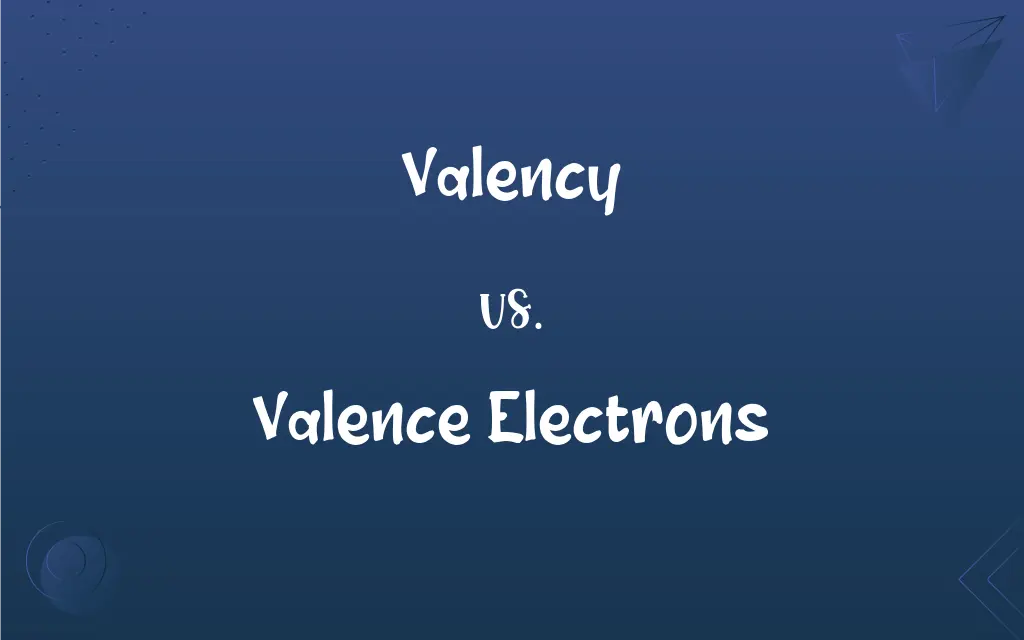Valency vs. Valence Electrons: What's the Difference?
Edited by Janet White || By Harlon Moss || Published on January 12, 2024
Valency is the combining power of an element, indicating how many atoms of another element it can bond with. Valence electrons are the outermost electrons of an atom involved in bonding.

Key Differences
Valency refers to the ability of an element to combine with other elements, usually measured by the number of hydrogen atoms it can bond with. Valence electrons are the electrons in the outermost shell of an atom that determine its bonding behavior.
In valency, the focus is on the atom's overall capacity to form bonds, which can vary with different compounds. In contrast, valence electrons are specific to the number of electrons available for bonding in an atom's outer shell.
Valency can sometimes be zero if the element is inert, reflecting its inability to bond with other atoms. Valence electrons for such inert elements are often in a stable configuration, preventing them from engaging in bonding.
The valency of an element is often determined by the number of valence electrons it has, but the two are not synonymous. Valency takes into account the entire bonding context, whereas valence electrons are purely a count of electrons.
Valency is a broader concept encompassing the atom's potential to bond, while valence electrons are a more specific term, focusing solely on the electrons that are directly involved in the bonding process.
ADVERTISEMENT
Comparison Chart
Definition
Combining power of an element
Outermost electrons in an atom
Role in Bonding
Indicates overall bonding capacity
Directly involved in bond formation
Variability
Can vary with compounds
Constant for a given element
Stability Indicator
Zero valency indicates inertness
Stable electron configuration suggests inertness
Relation to Electron Configuration
Inferred from electron arrangement
Direct count of outermost electrons
ADVERTISEMENT
Valency and Valence Electrons Definitions
Valency
Indicates the combining power of an element in terms of hydrogen atoms.
Carbon's valency in methane is 4, showing its ability to bond with four hydrogen atoms.
Valence Electrons
Electrons available for bonding.
Carbon has four valence electrons, allowing for versatile bonding patterns.
Valency
A measure of the bonding potential of an element.
The valency of nitrogen in ammonia is 3, as it forms three bonds with hydrogen.
Valence Electrons
Electrons in the outermost shell of an atom.
Sodium has one valence electron, making it highly reactive.
Valency
Reflects how many electrons an atom needs to gain, lose, or share to become stable.
Chlorine has a valency of 1, as it needs one more electron to achieve a stable configuration.
Valence Electrons
Electrons determining chemical properties.
The eight valence electrons of neon make it chemically inert.
Valency
The property of an element to bond with a certain number of atoms.
The valency of sodium in sodium chloride is 1, as it bonds with one chlorine atom.
Valence Electrons
Electrons used in forming chemical bonds.
Oxygen uses its six valence electrons to form two covalent bonds.
Valency
An atom's capacity to bond with other atoms.
Oxygen's valency of 2 allows it to form water by bonding with two hydrogen atoms.
Valence Electrons
Electrons that participate in chemical reactions.
Chlorine's seven valence electrons make it eager to gain one more for stability.
Valency
Variant of valence.
Valency
Senseid|en|chemistry}}{{alternative form of valence
Valency
The capacity of something to combine with other things, as for example the capability of a vaccine as measured by the number of pathogen serotypes that it can counteract.
Vaccine valency
Valency
The number of edges connected to a vertex in a graph.
Valency
Senseid|en|linguistics}}{{alternative form of valence
Valency
(uncountable) Importance, significance.
Valency
See Valence.
Valency
The phenomenon of forming chemical bonds
Valency
(biology) a relative capacity to unite or react or interact as with antigens or a biological substrate
Valency
(chemistry) a property of atoms or radicals; their combining power given in terms of the number of hydrogen atoms (or the equivalent)
FAQs
What is valency?
Valency is an element's capability to bond with other elements.
How does valency differ from valence electrons?
Valency is about bonding capacity, while valence electrons are the specific electrons involved in bonding.
Is valency always equal to the number of valence electrons?
Not always; valency can differ based on the element and its compounds.
How do valence electrons determine reactivity?
The number and arrangement of valence electrons determine an element's tendency to form chemical bonds.
Why is understanding valency important?
Valency helps predict how elements will react and bond with each other.
Can valency change in different compounds?
Yes, valency can vary in different chemical contexts.
Can valency be zero?
Yes, valency can be zero for inert elements.
What is the maximum valency an element can have?
The maximum valency depends on the element, typically up to 8 for p-block elements.
What are valence electrons?
Valence electrons are the outermost electrons of an atom that are involved in chemical bonding.
Do all elements have valence electrons?
Yes, all elements have valence electrons in their outermost shell.
How do valence electrons influence chemical properties?
The arrangement and number of valence electrons largely determine an element's chemical properties.
Are valence electrons always in the outer shell?
Yes, valence electrons are located in the atom's outermost shell.
How is valency used in chemical formulas?
Valency is used to determine the proportions of atoms in chemical compounds.
Is valency relevant in covalent bonding?
Yes, valency is crucial in determining how many bonds an atom can form in covalent bonding.
Does valency affect molecular structure?
Yes, valency influences how atoms bond and thus affects molecular structure.
Can valency be predicted from the periodic table?
Generally, yes, valency can be predicted based on an element's position in the periodic table.
Do transition metals have variable valency?
Yes, transition metals often exhibit variable valency.
How are valence electrons depicted in Lewis structures?
In Lewis structures, valence electrons are represented as dots around the atomic symbol.
Do noble gases have valence electrons?
Yes, noble gases have valence electrons but usually do not participate in bonding due to their stable configuration.
What role do valence electrons play in ionic bonding?
In ionic bonding, valence electrons are transferred between atoms.
About Author
Written by
Harlon MossHarlon is a seasoned quality moderator and accomplished content writer for Difference Wiki. An alumnus of the prestigious University of California, he earned his degree in Computer Science. Leveraging his academic background, Harlon brings a meticulous and informed perspective to his work, ensuring content accuracy and excellence.
Edited by
Janet WhiteJanet White has been an esteemed writer and blogger for Difference Wiki. Holding a Master's degree in Science and Medical Journalism from the prestigious Boston University, she has consistently demonstrated her expertise and passion for her field. When she's not immersed in her work, Janet relishes her time exercising, delving into a good book, and cherishing moments with friends and family.































































